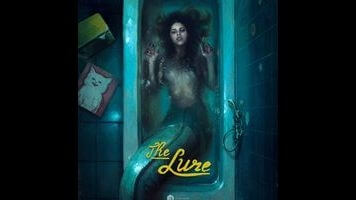It’s also a uniquely Eastern European film, built around the world of “dancing restaurants” that were popular in Poland during the late Communist era. Filmed largely in an abandoned nightclub in Warsaw where songwriters Barbara and Zuzanna Wronska’s parents performed in the 1980s, The Lure takes place in a kitschy, ramshackle fantasia of ’80s Poland, a stylish, occasionally Lynchian world where mermaids not only exist but are also celebrities. The story begins with sisters Silver (Marta Mazurek) and Gold (Michalina Olszańska), two mermaids who decide to leave the sea behind and become nightclub singers. For this, they team up with Wokalistka Krysia (Kinga Preis), an aging cabaret performer fond of chain smoking and gaudy wigs, who incorporates them into her act.
Soon, Silver and Gold are the darlings of the Warsaw nightlife scene—a sexy photo shoot where the sisters pull fishnets over their tails is a nice touch—and Silver falls in love with handsome young bass player Mietek (Jakub Gierszal). But their courtship is complicated, not just because Silver has no genitals in her human form. Meanwhile, Gold is tempted to succumb to much darker urges—namely, the thirst for human blood that is the reason mermaids are blessed with angelic voices to begin with. (It’s easier to lure men into the water so you can eat them if you sing them a pretty song.) These discordant views on the proper treatment of human men cause a rift between the sisters.
Fantastic transformations serving as a metaphor for sexual coming-of-age have been explored before, recently in French filmmaker Lucile Hadžihalilović’s Evolution. But The Lure is a more accessible film than Hadžihalilović’s and offers visceral pleasures both delightful (the bubbly nightclub numbers) and horrific (Gold’s violent nighttime adventures). In fact, some of the movie’s most striking images come from the juxtaposition of these two states, as in a scene where Silver sings a musical number while being cut in half on an operating table. The film’s special effects also embrace the grotesque: The sisters’ tails, which appear whenever the bottom half of their bodies gets wet, gleam beautifully under colored spotlights before landing on the stage with a dull, fishy thud.
Smoczyńska’s visual sense remains distinct throughout, bathing the film in pink, purple, and various shades of green, from frothy sea foam to wet pine. Sometimes the effect is soft and feminine, other times it’s sharp and jarring, depending on the emotion of the scene. The music, which appears in both performance scenes and in a classic “burst into song in the middle of the supermarket” musical context, is similarly diverse, touching on disco and punk as well as more conventional show tunes. But while the film is long on style, it’s short on plot. The Lure shows many of the structural shortcomings typical of new directors, drawing out some sequences for the sheer love of the image and giving other, major story beats a cursory treatment. But Smoczyńska’s vision for the film is strong, and especially if you put The Lure next to the myriad other variations on the same fairy tale that have been produced over the years, quite refreshing.

